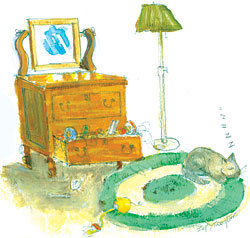(Illustration: Bill Firestone)
There are junk drawers, and then there are old-house junk drawers. The first is universal to all American homes, from condos to cottages. Crammed with twist ties and stray screws, the standard junk drawer is a sanctuary for items we hoard out of practicality or affection or the nagging fear that this may come in handy some day (think of the hex key used once to assemble IKEA shelving).
But the old-house junk drawer is more than a household helper. It is a true survival kit, accumulating some very specific items that can’t be found in ordinary homes. Even its commonplace contents have uses unique to homes fitting that double-edged description, charming. In our house, some junk-drawer cardboard slipped under the torchère creates the optical illusion that the lamp is standing straight when it’s actually crooked but in line with the window frame. A piece of Velcro will latch the medicine cabinet until the bathroom reaches its turn in the renovation rotation.
Here’s what we count on finding in our own old-house junk drawer:
- Wire in two colors, brown for discreetly straightening wayward cabinet doors, green for invisibly snugging a fern into the alcove so visitors squeezing by in heavy coats won’t knock it over.
- Picture hangers that fit existing holes of varying sizes. In my home office, formerly a bedroom, the bulletin board hangs in a peculiar spot 8″ higher than the calendar, and the calendar hangs about 1/4″ from the bookshelf. But they won’t be rearranged more aesthetically because saving the plaster from unnecessary pounding is top priority.
- Packing tape, for returning those purchases that aren’t quite right but that could only have come from restorers’ mail-order catalogs and Web sites. The local Wal-Mart simply does not stock cast brass square cup casters.
- Rug tape, to keep area rugs artfully arranged to show off the hardwood floors. (And under the sink, the junk-drawer annex, hardwood floor cleaner, within easy reach during a red-wine-spill-induced panic.)
- Measuring tape, for the hold-your-breath moment when you bring home that flea-market console and pray that it really will fit perfectly in the dining room nook that’s juuuust too small for standard-sized pieces.
- Abandoned cat toys. Let’s face it. While cats accessorize the parlor so beautifully, they show affinity for certain toys for 10-minute segments. After that, complete rejection.
- Crazy Glue. Sure, it never really works. But when the cat knocks the majolica vase off the built-ins, we can dream, can’t we?
- Flashlight, to give the man of the house some light when heês sent into the basement crawl space to retrieve the cat who bolted after breaking the vase. The dark recesses of old houses mean that junk-drawer flashlights are for more than power outages. A colleague of mine who lives in an old house once followed a flashlight beam on the trail of a pitifully mewing but out-of-sight cat and discovered a hidden cistern in his basement.
- S-hooks, because our closets (all two of them) refuse to conform to the organizing gadgets and gear that have miraculously decluttered everyone else’s homes. We continue to rely on our wits, using s-hooks in organizing schemes that involve hanging baskets from shelves and hardware from pegboards.
- Sharpies, for marking the baskets and pegboards so we can find things once they’re organized. The organizing craze seems to have bypassed the classic junk drawer, but all those DIY websites like to imply that reform is possible. The basic gist of their junk drawer organizing tips: Arrange stuff by category, line drawer with egg cartons, put stuff in. What they don’t say: Wait three months. Note return of disarray.
- Paint samples from past projects, in case we need to reference the colors again. They live in the junk drawer because we know, in our heart of hearts, that we never will get around to gathering all those details in a renovation journal.
And for the benefit of future generations, I would add one junk-drawer contribution that could be the most important of all. If we’re lucky, our restoration projects have uncovered inscriptions on the walls by plumbers from 1910 and homeowners from 1930. These messages from the past reveal linkages, affirming our place in the chain of owners who have loved, hated, neglected, abused, or coddled our beautiful homes. As we renovate and restore, we can memorialize our place in the chain of ownership by inscribing the bare walls with our names, there for future renovators to uncover, and written with—what else—a pencil pulled from the junk drawer.
M. Diane McCormick, her husband, and cat live in Harrisburg, Pennsylvania. She is president of Historic Harrisburg Association, a preservation advocacy organization.







